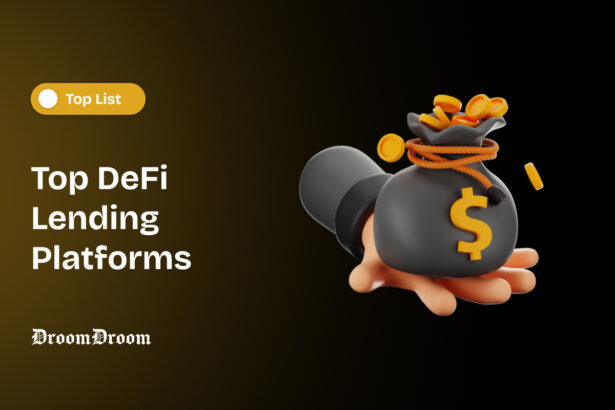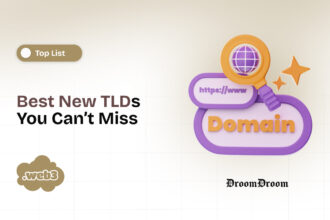DeFi lending platforms are shifting our approaches to borrowing and lending that are not conducted through intermediaries, allowing us full control over our financial experiences. Therefore, in this dynamic world, we will examine the top six DeFI platforms dominating.
- What is DeFi Lending?
- Smart Contracts
- Collateralization
- Interest Rates
- Global Accessibility
- Transparency
- Decentralization
- Innovation
- Which DeFi Lending Platforms are the best and why?
- What are the Advantages of DeFi Lending?
- Decentralization
- Global Accessibility
- Transparency
- Innovation
- Flexibility
- Earn Interest
- Lower Costs
- Programmability
- What are the Disadvantages of DeFi Lending?
- Conclusion
Defi lending has gained much popularity because of its borderless, permissionless, and transparent nature, which is different from mainstream financial services. However, users should be aware of associated risks such as smart contract vulnerabilities and high market volatility as DeFin lending involves.
What is DeFi Lending?
DeFi lending refers to the practice of lending and borrowing financial assets using decentralized blockchain technology and smart contracts. Unlike traditional lending, which involves banks or other centralized financial institutions as intermediaries, DeFi lending platforms operate on blockchain networks like Ethereum, Binance Smart Chain, or others.
Certain tools are applied to ensure lending occurs safely and efficiently within DeFi lending.
Smart Contracts
A smart contract is a contract where the conditions within the contract are coded and the contract gets executed without human interference. These smart contracts automatically enable the lending and borrowing process without intermediaries in DeFi lending.
Smart contracts play a crucial role in DeFi, read this article to learn their role in DeFi.
Collateralization
The borrower should always have enough crypto assets as security for the loan while getting it on the DeFi Lending platform. The collateral is stored within a smart contract and could be liquidated to cover losses in case the borrower fails to pay back the loan.
Interest Rates
In DeFi lending, interest rates are set according to a process dictating the equilibrium of demands and offers generated internally among the platform users. Users can gain additional revenue for their loaned-out assets, while at the same time, borrowers will have to pay interest for any loan amount obtained by them. They are usually fluctuating concerning market dynamics.
Global Accessibility
Anyone using the internet and owning a compatible digital wallet can participate in decentralized finance (DeFi) lending. The inclusivity creates market entry opportunities for people left out of conventional banks.
Transparency
The blockchain underpins all transactions and activities on the DeFi lending market, ensuring transparency. Transactions can be authenticated and traced continuously by users.
Decentralization
DeFI lending occurs in a decentralized network, so no governing authorities oversee the operation. Such decentralization lowers the possibility of censorship and increases security.
Innovation
Most DeFi lending platforms are modern and have included elements like flash loans, algo lending, and liquidity mining. The unique features strive to maximize returns for users as well as create vibrant and highly functional ecosystems.
Which DeFi Lending Platforms are the best and why?
The ”best” DeFi lending platforms will depend mainly on what each individual looks into during the lending or borrowing of an asset.
Compound Finance
It was established by Robert Leszner in 2017. However, Compound has an experienced team that strives to develop a straightforward DeFi lending service. It supports several cryptocurrencies, which include Ethereum-backed assets such as ETH, DAI, and USDC, among others. Interest rates in a compound are algorithmically determined depending on the supply and demand of assets. It is user-friendly, and it was one of the first DeFi lending protocols.
Aave
Stani Kulechov established Aave in 2017. The innovative team behind Aave helps in its development as a platform. Aave supports different sorts of currencies, such as popular tokens and other lesser-known assets. One notable aspect of Aave has been the provision of features such as flash loans and the opportunity to switch between fixed and variable-rate interest. It is user-friendly and flexible.
MakerDAO
Rune Christensen is the founder of MakerDAO, which dates back to the year 2014. Team MakerDAO is dedicated to the decentralized stablecoin platform, which led it to the leader spot within the Defi realm. Makerdao focuses on Ethereum and generating DAI, which is a stablecoin pegged at the value of the USD. The unique capability of MakerDAO lies in collateralized debt positions (CDP) that lead to the issuance of DAI to maintain normalcy in a decentralized financial space.
Yearn.finance
Andre Cronje created yearn. finance in 2020. Yearn. finance uses a community-driven development model, and its developer is Andre Cronje, who is a prominent figure within the crypto community. It also incorporates yearn. finance, which offers support for many assets, and the strategies’ main objective is to enhance yields through an auto-switching of capital among varied DeFi lender platforms. Yearn. Finance has been at the forefront of the development of user-friendly strategies that allow for automated optimization of yield from various platforms.
Curve Finance
The launch of Curve Finance was in 2020 by Michael Egorov. Curve Finance concentrates on stablecoins. It specializes in stablecoins such as Dai, USDC, and USDT. One of the strong points of Curve is that it emphasizes various stablecoin liquidity pools with no slippage and stable returns.
Synthetix
Kamin Warrick founded Synthetix, which initially operated as Havven, back in 2017. Synthetix aims to secure assets for use in the blockchain by its members. Synthetix enables users to create synthetic tokens, which are backed by commodities, fiats, or even cryptos. However, Synthates is Synthetix’s most distinct characteristic, which gives users access to a variety of assets without being owners as such.
It’s essential to note that the “best” platform depends on individual preferences, risk tolerance, and specific use cases. Users should conduct thorough research and consider factors such as security, governance, and user experience before choosing a DeFi lending platform.
What are the Advantages of DeFi Lending?
DeFi lending possesses a lot of added features that have made it quite popular in the financial environment. Here are some key advantages:
Decentralization
The operation of de-fi lending reduces dependency on banks and other intermediaries, with the transaction being done through decentralized blockchain networks. It doesn’t require bank services, and users have full custody of their own money. Decentralization also promotes financial inclusion and enables participation in financial services worldwide.
Global Accessibility
Anyone with access to the internet and a compatible digital wallet can participate in DeFi lending platforms.
This creates financial options for people who may be left out of normal banking, especially in geographical areas with poor bank networks.
Transparency
Transactions and activities carried out on DeFi lending platforms are recorded transparently on the blockchain. Transaction verification and monitoring enable the tracking of funds in real-time, which translates into more reliable and accountable financial systems.
Innovation
In most cases, DeFi lending platforms comprise advanced elements such as flash loans, algorithmic credit, and liquidity extraction. The innovations are targeted at improving user’s returns by enabling them to discover new ways of interacting with the financial market.
Flexibility
The assets that users can lend or borrow are flexible on DeFi lending platforms. The platform offers users varying options in cryptocurrency and assets, allowing them to make their strategies depending on individual needs and the risks accepted.
Earn Interest
People are rewarded for depositing and lending out their assets in the decentralized finance ecosystem. With this, users can take advantage of their money, earn interest from their bank deposits, and build up their fortune passively.
Lower Costs
Lending at DeFi is cheaper than with conventional banking services. Smart contracts can help users avoid paying for intermediary services while increasing their chances for a favorable return on investment thanks to automation.
Programmability
DeFi lending is programmable, enabling one to come up with very intricate financial tools as well as advanced tactics. The programmability of this system allows for complex lending and borrowing practices that allow the user more flexibility.
What are the Disadvantages of DeFi Lending?
Although several advantages have been observed in the DeFi in recent years, it is necessary not only to be attentive but also mindful of the potential risks involved.
Here are some notable drawbacks:
Smart Contract Risks
Smart contract vulnerabilities offer backdoors through which various attacks against the supportive DeFi loaning security system can be carried out. This implies that there are possibilities for loss that may arise from an exploit or bug in smart contract code. Users also have to go through security audits and codes before partaking in DeFi protocols.
Market Volatility
This is primarily because the cryptocurrency market tends to be very volatile and, at times, cannot be used instead of money for unsecured assets. Such can lead to an instance where collateral is sold off to pay for a loan whose price fluctuates, leading to liquidation. Consequently, it exposes lenders as well as borrowers to higher risks.
Lack of Regulation
Operating in an unregulated space is relatively straightforward compared to traditional finance. Without proper regulation, users are susceptible to falling for scams, frauds, and unreliable services. Accordingly, this method may mean that the parties have no recourse following a disagreement.
Learning Curve
The DeFi platforms can be difficult to comprehend, so you probably have to start learning about lending and borrowing as well as other protocols. Engaging with DeFi platforms is difficult for most users who do not have experience dealing with the blockchain or a decentralized world.
Centralization of Governance
Some DeFi platforms have governance structures that promote the act of making decisions centrally. This, for instance, can affect the perception that the DeFi intends to establish as decentralized and fair by having few controlling parties or participants within it, such as those who may influence its outcome.
Conclusion
With key features like decentralization, global availability, transparency, and flexibility in DeFi lending. Smart contracts enable users to interact directly with one another without the use of intermediaries, thus giving them more autonomy in their financial relations. The incorporation of several stakeholders in DeFI allows global users to promote financial inclusion by eliminating the entrance barrier.
Nevertheless, these benefits have their negative features attached to them. The cautious use of DeFi lending services entails smart contract risks, market instability, regulatory uncertainty, and a learning curve. Users should use only those platforms with a high level of security, full audits, and clear governance.
The participants in the DeFi space must remain up-to-date, adopt modern strategies, and overcome emerging regulations. DeFi lending has become a new paradigm for financing, which gives everyone equal chances but also leads to different risks. The essence of success here is to understand all the risks and advantages associated with users studying these products.




















